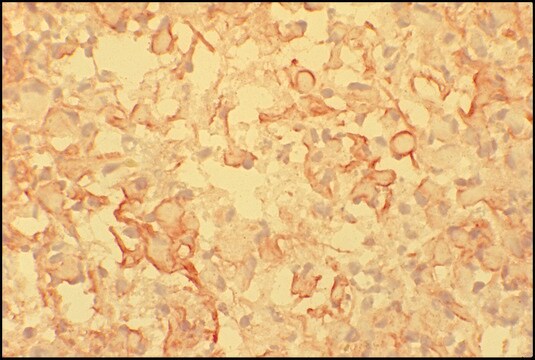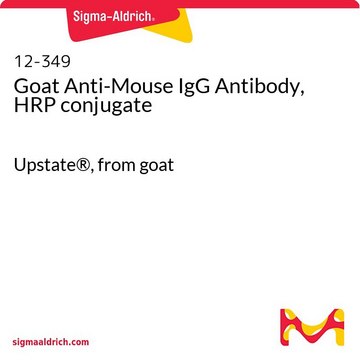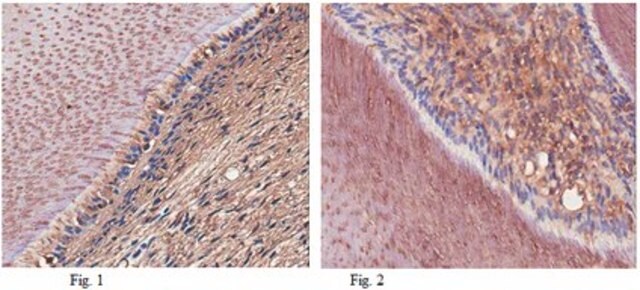F9384
Anti-Mouse IgA (α-chain specific)−FITC antibody produced in goat
affinity isolated antibody, buffered aqueous solution
Synonym(s):
Goat Anti-Mouse IgA (α-chain specific)−Fluorescein isothiocyanate
Sign Into View Organizational & Contract Pricing
All Photos(1)
About This Item
Recommended Products
biological source
goat
Quality Level
conjugate
FITC conjugate
antibody form
affinity isolated antibody
antibody product type
secondary antibodies
clone
polyclonal
form
buffered aqueous solution
technique(s)
direct immunofluorescence: 1:16
storage temp.
2-8°C
target post-translational modification
unmodified
General description
IgA antibody is secretory antibody and is present abundantly in mucous linings of gastrointestinal, respiratory and genitourinary tracts, tears and saliva. Thus secretory IgA contributes to the humoral defense mechanism against the pathogens on mucosal surfaces
Anti-Mouse IgA (α-chain specific)−FITC antibody is specific for α chain of mouse IgA. The purified IgA fraction is conjugated to Fluorescein Isothiocyanate (FITC), Isomer I.
Anti-Mouse IgA (α-chain specific)−FITC antibody is specific for α chain of mouse IgA. The purified IgA fraction is conjugated to Fluorescein Isothiocyanate (FITC), Isomer I.
Immunogen
Purified mouse IgA
Application
Anti-Mouse IgA (α-chain specific)−FITC antibody may be used for direct immunofluorescent labeling of mouse spleen cells at a minimum working dilution of 1:16. The antibody was used to label platelets from human or mice after incubation with primary antibody against β3 integrin.
Physical form
Solution in 0.01 M phosphate buffered saline, pH 7.4, containing 1% bovine serum albumin and 15 mM sodium azide.
Disclaimer
Unless otherwise stated in our catalog or other company documentation accompanying the product(s), our products are intended for research use only and are not to be used for any other purpose, which includes but is not limited to, unauthorized commercial uses, in vitro diagnostic uses, ex vivo or in vivo therapeutic uses or any type of consumption or application to humans or animals.
Not finding the right product?
Try our Product Selector Tool.
Storage Class Code
10 - Combustible liquids
WGK
WGK 1
Flash Point(F)
Not applicable
Flash Point(C)
Not applicable
Choose from one of the most recent versions:
Already Own This Product?
Find documentation for the products that you have recently purchased in the Document Library.
Heidi Tiller et al.
Transfusion, 52(7), 1446-1457 (2012-01-19)
Fetal and neonatal alloimmune thrombocytopenia (FNAIT) is a severe bleeding disorder caused by maternal antibody-mediated destruction of fetal or neonatal platelets (PLTs). Results from our recent large screening study suggest that the pathophysiology of FNAIT is more similar to hemolytic
B Manoury-Schwartz et al.
European journal of immunology, 25(12), 3235-3242 (1995-12-01)
Native type II collagen (CII) is a high molecular-weight fibrillar molecule which induces a chronic polyarthritis in mice expressing the H-2q haplotype. The present study was initiated to analyze the processing and the presentation of this nonglobular protein by H-2q
Hao-Jing Wen et al.
Molecular medicine reports, 19(1), 660-666 (2018-11-16)
A high level of oxidized low‑density lipoproteins (oxLDLs) is an independent risk factor for cardiovascular disease. The aim of the present study was to investigate whether insulin‑like growth factor‑1 (IGF‑1) protected endothelial progenitor cells (EPCs) from injury caused by ox‑LDLs
Robert W Garvey et al.
ChemMedChem, 17(10), e202100759-e202100759 (2022-03-15)
Mounting evidence suggests that the serotonin system serves in signal transmission to regulate insulin secretion in pancreatic islets of Langerhans. Among the 5-HT receptor subtype found in pancreatic islets, serotonin receptor 1A (5-HT1A ) demonstrates a unique ability to inhibit
D C Shieh et al.
Autoimmunity, 15(2), 123-135 (1993-01-01)
Type I, insulin-dependent diabetes (IDD) results from an autoimmune response against the insulin producing pancreatic beta cells. This autoimmune reaction involves both humoral and cell-mediated factors; nevertheless, the relative role of each remains unresolved. Furthermore, while adoptive transfer experiments have
Our team of scientists has experience in all areas of research including Life Science, Material Science, Chemical Synthesis, Chromatography, Analytical and many others.
Contact Technical Service








